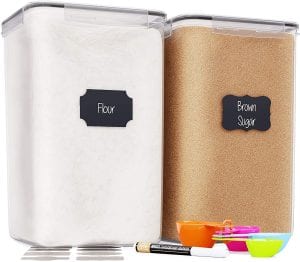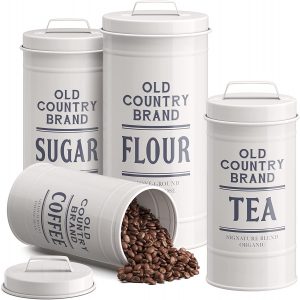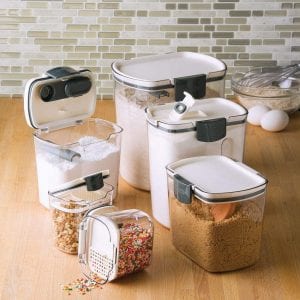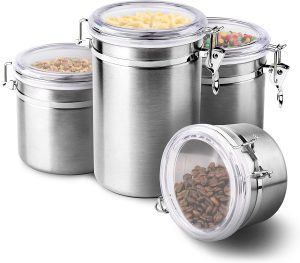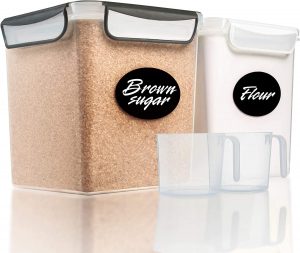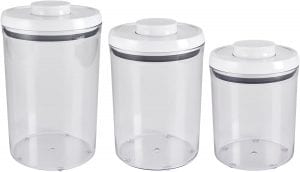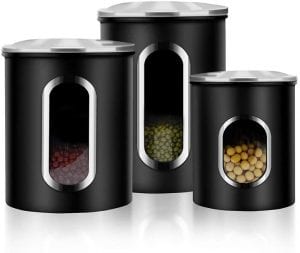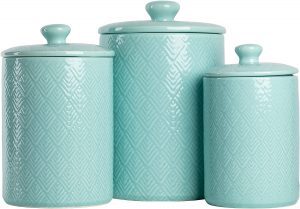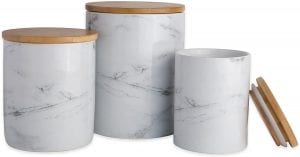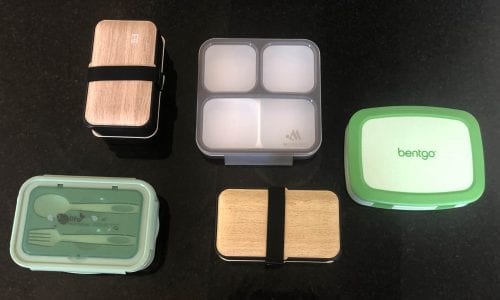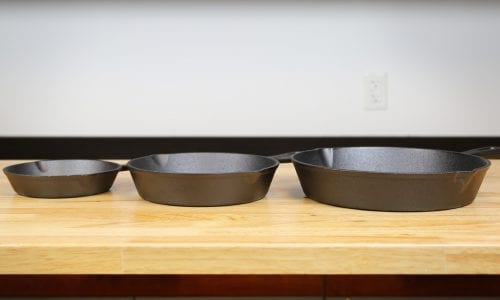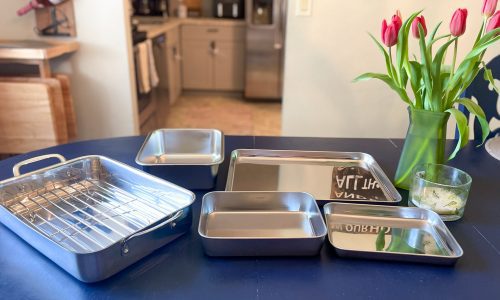The Best Flour & Sugar Canisters
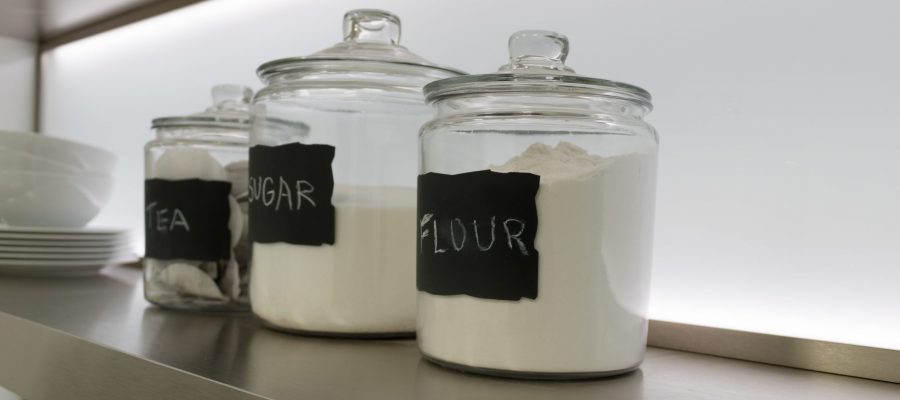
Our Review Process
Don't Waste Your Money is focused on helping you make the best purchasing decision. Our team of experts spends hundreds of hours analyzing, testing, and researching products so you don't have to. Learn more.
Our Picks For The Top Flour & Sugar Canisters
- 1. Chef’s Path BPA-Free Flour & Sugar Canisters, 2-Piece
- 2. Barnyard Designs Decorative Rustic Flour & Sugar Canisters, 4-Piece
- 3. Progressive International Prepworks Plastic Flour & Sugar Canisters, 6-Piece
- 4. ENLOY Airtight Clamp Lid Flour & Sugar Canisters, 4-Piece
- 5. GoodCups Leak Resistant Flour & Sugar Canisters, 2-Pack
- 6. OXO Good Grips Round Flour & Sugar Canisters, 3-Piece
- 7. Malmo Transparent Window Flour & Sugar Canisters, 3-Piece
- 8. 10 Strawberry Street Ceramic Flour & Sugar Canisters, 3-Piece
- 9. DII Modern Marble Flour & Sugar Canisters, 3-Piece
This set of two sizable, clear canisters is great for anyone who buys in bulk. Each storage jar holds 7 quarts, and the set includes four measuring cups, eight reusable labels and a chalkboard pen. They are airtight and food-safe, so you can use them for flour, sugar, cereal, beans and other dry food items.
Perfect for Large QuantitiesEasily store and label all of your pantry goods with these flour & sugar canisters.
Add some modern barnyard charm to your countertops or shelves with this rustic stainless-steel flour & sugar canisters set. Each piece has a silicone seal built into its lid, making it airtight to keep you food fresh and dry.
A Little Country FlairThe perfect addition to your kitchen décor, these containers will protect flour and sugar.
Chefs will delight in this six-piece clear flour & sugar canisters set, which includes six canisters with functional, included utensils. Each piece is designed to make your work easier, with features like measurement markings, spoons and leveling bars. You will also appreciate the easy-catch latches and stainless-steel hinges.
Integrated ToolsKeep your pantry items safe with these storage elements; they boast built-in tools for your convenience.
The biggest draw to this set of flour and sugar canisters is the airtight clamp lid. Insects and moisture are kept out and freshness is sealed in. The four included canisters are also a cinch to clean by hand, although you can put them in a dishwasher if you wish.
Durable Stainless SteelThese flour & sugar canisters can also be used for storing candy, coffee, tea bags and sugar.
Buying Guide
Canister sets make for wonderful home organization tools, and they can be used in any room of your house. If you plan to use them to store dry food, choose ones designed for this purpose; they should have airtight seals. Clear ones are ideal when you want to know what is inside, but some are printed with words like “flour” or “coffee,” so you won’t have to guess.
Before buying, check to see how much space you have for the canisters. Some kitchen closets are small, so canisters that stack might be a good pick. These sets can be made from plastic, stainless steel, ceramic or other materials. Product descriptions should include item measurements and weights, so if you don’t want something too heavy, avoid ceramic and similar materials. Also, check to see if the containers you’re considering are dishwasher-safe; hand-washing and air-drying can be time-consuming.
What to Look For
- Some canisters are designed to hold specific amounts, like a five-pound bag of flour. This is helpful because you won’t have to fill it up as often. It will be heavier, though.
- See what size openings the canisters have. They should be large enough to fit a scoop or measuring cup if you plan to use them for flour, sugar and other similar kitchen essentials.
- When shopping for canisters to store food, one of the most important features is an airtight seal. See what kind of mechanism the seals have, too.
- Plastic can be easy to clean, but be sure to buy containers that are BPA-free.
More to Explore
What’s the best way to store flour?
Flour stored in its original paper sack only lasts about three months. However, it doesn’t take much effort at all to increase the shelf life. If you only cook or bake occasionally, here’s how you can make your flour last as long as possible.
Use Your Freezer
The gross part about food storage is if you don’t store certain ingredients properly, they can attract bugs and unfortunately, flour is one of those products that can already have the beginnings of an infestation before it enters your home. So it’s best to proceed with caution to reduce the chances of having moths inundating your kitchen.
One of the best ways to prevent a bug infestation is to take on preventative measures. If you’ve brought home a new bag from the grocery store and are concerned about bugs, place the paper sack in the freezer for two days. This will ensure any insects or eggs that have slipped through the milling process will be killed.
You can also keep whole grain flour in your freezer for up to one year and white flour for up to two years. Just be sure to defrost it only what you need some and let the ingredient return to room temperature before usage. Otherwise, it won’t rise properly. Also avoid defrosting and refreezing your flour frequently as it degrades the quality. If you decide to use your freezer for long-term storage, vacuum sealing or Mylar bags are recommended. Removing as much air as possible will help preserve freshness.
What To Know About Flour Bugs
Unfortunately, pest infestation can happen. Flour bugs, known as weevils, rice bugs, wheat bugs or flour worms, are tiny beetles that set up shop inside your flour and then infest the rest of your kitchen, feasting on dry food such as flour, cereal, rice, pasta and more. As if that’s not icky enough, they lay eggs inside the flour to grow their communities.
Since eggs are too small to be seen in the flour, you likely won’t know they’re there unless they’ve started to hatch. Here are some things to look out for:
- Light brown or gray worm-like creatures
- Any cobweb-like substances on the flour
- Any insect parts, such as a wing
Deter bugs by placing a bay leaf inside the container when stored in the pantry, or keep your flour in the freezer or refrigerator.
Say Goodbye To The Paper Bag
Although it’s considered a non-perishable food, spoilage can occur. When the oils in the flour degrade, it can be exposed to heat, light, oxygen and moisture.
The paper bag used to contain your 2-pound sack of flour was designed to help you get it from the store to your home — but after that point, it’s best to transfer the flour into an airtight container, no matter where you store it. That can be in a large glass, metal or plastic container with a tight lid or double plastic bag.
Airtight containers will help your kitchen look and feel more organized and can keep flour from spoiling for up to 10 months. Placing an oxygen absorber inside the sealed container can also help prevent oxidation and extend your flour’s shelf life. If possible, label the container or bag with the “best by” date to help you stay on top of freshness.
Store Flour In A Pantry
Pantries offer a cool, dark, dry place to store flour, which will work well for at least one year. The pantry can be your go-to place if you live in a colder or drier climate. However, if you live in a humid climate or plan to keep the flour for more than a year, you might opt for the fridge or freezer.
Use The Refrigerator
As long as flour is stored in an airtight container, many varieties of flour will last up to a year in the refrigerator.
How To Tell If Flour Has Gone Rancid
Telltale signs that flour has gone bad include the old-fashioned sniff test. If the flour has oxidized, it will smell like Play-Doh. It might also smell slightly sour or musty. While we never want to waste food, the altered flavor and aroma will transfer through to the finished product, so it’s best to toss it out immediately.
Now that you know how to properly store flour, you can make the most out of every sack. Is anyone up for homemade pizza?
– by Emily O’Brien

